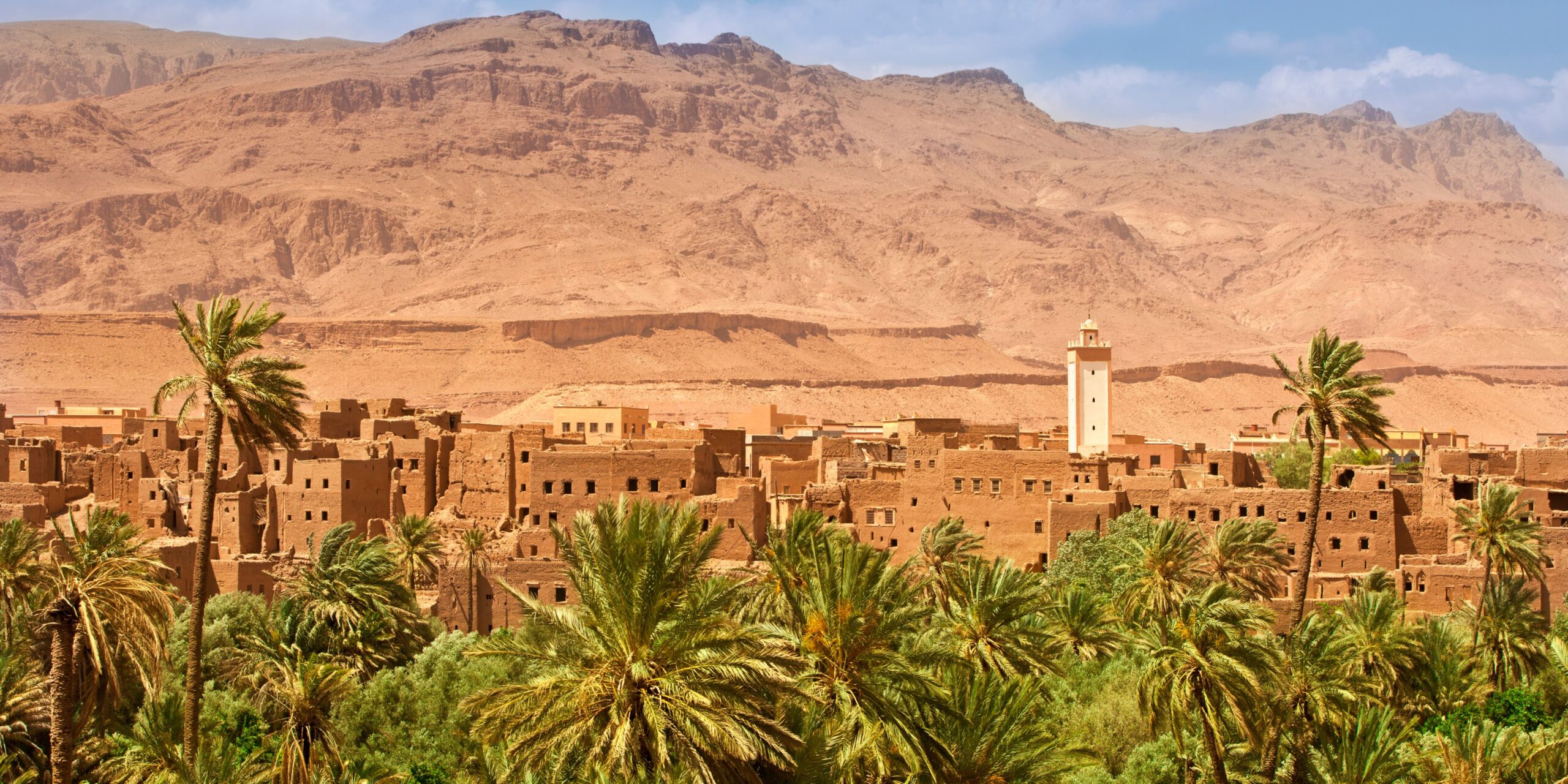Morocco’s natural landscapes are wildly varied: soaring peaks, lush cedar forests, mountain lakes, and golden sand dunes. This guide highlights key outdoor escapes, with tips on trekking, camping, eco-lodges, and cultural encounters with Berber and nomadic communities.
Atlas Mountains (High & Middle)
The Atlas range splits into High, Middle and Anti-Atlas sections. In the High Atlas, Jebel Toubkal (4,167 m) dominates – North Africa’s highest peak (in Toubkal National Park). It’s a magnet for trekkers: guides and mule trains are available from the village of Imlil. Berber villages line the valleys; stay in a guesthouse or the Kasbah du Toubkal eco-lodge, and share mint tea with locals. The Middle Atlas around Ifrane features cedar forests, oak groves and alpine lakes. The cedar woods host about 25% of the world’s Barbary macaques, and Ifrane National Park spans hundreds of km² of cool forest and even ski slopes. Local Berbers herd goats and sell honey, cheese and apples in mountain markets.
Mount Toubkal
The ascent to Mount Toubkal (4167 m) is a classic Moroccan trek. From Imlil one can reach the Toubkal refuge (3207 m) on day 1, then summit early on day 2 for sunrise views over the desert. The trail passes streams, juniper woodlands and terraced fields of potatoes and apricots. On a clear day you see the High Atlas ridges radiating below. Descend via the same route or take an alternate path through waterfalls.
Local Insight: Hiring a Berber guide and mule is easy in Imlil; they often cook your tagine at camp. Porters can carry extra gear (for a fee).
Sahara Desert
Morocco’s Sahara begins near Erfoud and Merzouga. The immense dunes of Erg Chebbi (around Merzouga) and Erg Chigaga (near M’Hamid) offer unforgettable nights under the stars. Arrange a camel trek or 4×4 tour to the dunes – a popular circuit is to ride camels at sunset, stay overnight in a desert camp (with blankets, dinner and tea), then watch the sunrise. The vast silence and sand seas are magical. Nearby, visit the ksar of Aït Benhaddou – a UNESCO-listed earthen fortress on the old salt caravan route.
Where to stay: Luxury desert camps (with solar-heated showers) or simple nomad bivouacs; in Merzouga village there are small hotels and gîtes. In Zagora or M’Hamid, desert guesthouses welcome travelers.
Sample itinerary (Sahara): 4–5 days: Marrakech – High Atlas – Dades Gorge – Erfoud – Merzouga (overnight in desert camp) – Rissani – Zagora – back via Aït Benhaddou – Ouarzazate – Marrakech. This circuit covers dunes, gorges, and a night in the Sahara.
Ouzoud Waterfalls
Ouzoud (in the Azilal province) features a 110 m waterfall plunging in terraces through olive orchards. (“Ouzoud” means “mills” in Berber, after the old watermills on the falls) It’s a lush canyon: Barbary macaques often play on the rocks and in the trees. You can hike down the steep path to the pool’s edge (or ride a mule), or take a boat under the cascades. Cafés on both sides serve orange juice and tagines with a view of the falls.
Season: Summer months fill the falls; spring brings peak water flow.
Sample itinerary (Ouzoud): Early start: trek to the canyon rim at sunrise for golden light on the falls, then hike down (or mule) to the base. Lunch riverside (fresh trout is a specialty). Afternoon: hike along the river to higher pools or relax with oranges and mint tea by the water.
Ifrane and Cedar Forests
Ifrane National Park (Middle Atlas) is famous for its cedar forests and wild monkeys. Cedrus atlantica and Algerian oaks cloak the slopes around Azrou.
The area is great for family picnics by mountain lakes (like Dayet Aoua) and spotting Barbary macaques. The town of Ifrane itself feels Alpine (chalet-style hotels and a ski hill at Michlifen).
Where to stay: Ifrane has classic hotels (e.g. Ifrane Palace); nearby Mic
National Parks and Trekking Tips
Morocco’s parks protect its wild heritage. Besides Toubkal and Ifrane NP, visit Souss-Massa National Park (south of Agadir) for birdlife and argan forests, or Tazekka NP (Middle Atlas) for caves and forests. In all parks, eco-lodges and Berber guesthouses provide authentic stays.
Camping: In the Sahara you can camp anywhere (no permit needed) – expect basic facilities. In the Atlas, official campsites (e.g. by Lakes Bin el Ouidane or Aguelmame) have toilets/showers.
Weather & Gear: Mountains: snow is common Nov–Apr on high peaks, so pack warm layers even in summer nights. Sahara: blazing hot days and cold nights; bring sunscreen and a warm blanket.
Etiquette: Hire local guides when possible – their knowledge of trails and customs is invaluable. Respect traditions: dress modestly in Berber villages and ask before photographing people.
Sample itinerary (Toubkal): Day 1: Marrakech–Imlil (1700 m) – trek ~7 km to a guesthouse (2500 m) in Aremd valley. Day 2: Summit Mt. Toubkal and descend to Imlil. Sample itinerary (Ouarzazate & Dades): 2–3 days: Marrakech–Telouet–Aït Benhaddou (overnight)–Skoura date palms–Dades Valley (gorge)–return. This covers desert kasbahs and mountain scenery.

